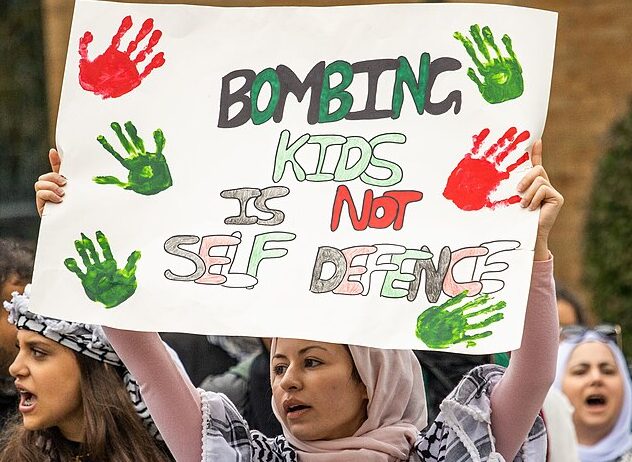A new article by M.T. Samuel examines Hamas’s targeting of civilians, the dispossession of Palestinians, and Israel’s crackdown on nonviolent protest.
With the death toll in Gaza soaring past 18,000—and cases of infectious disease reported at more than 350,000 as the enclave’s health system collapses—even Joe Biden acknowledges that Israel is losing international support. While the president has been the staunchest defender of Israeli Prime Minister Benjamin Netanyahu’s war on Hamas, and the United States vetoed a UN Security Council resolution calling for a ceasefire, the vice president and secretary of state have begun to call on Israel to protect civilians.
A new article published by Middle East Policy decries Hamas for its own war crimes, as it targeted and slaughtered Israeli civilians on October 7. However, M.T. Samuel argues, “As far as international law is concerned, Israel’s oppressive, dispossessive, self-determination-denying occupation of the West Bank and its suffocating 16-year blockade of the Gaza Strip indeed provide the crucial context for Hamas’s attack.”
The article appears in a special issue on the Gaza war, which is free to read without a subscription, and it will be published in the forthcoming Winter 2023 journal.
Samuel, a legal scholar who studies Indigenous communities in the Middle East and the Anglosphere, demonstrates that international law has “continuously facilitated Palestinian dispossession” since the early 1920s. “From the moment the 1917 Balfour Declaration…was incorporated into the document that legalized Britain’s mandatory government in that territory,” Samuel writes, the League of Nations “effectively authorized Britain to facilitate Zionist colonization in violation of its legal obligation” to recognize the right to self-determination of indigenous Palestinians, who constituted nearly 90 percent of all people in Palestine.
Since that time, the Zionists and, after 1948, the state of Israel have “conquered and occupied more than half of the territory allocated for the Palestinians in the partition plan,” including Gaza and the West Bank. Despite these violations of international law, Samuel argues, “Palestinians are expected comply with that same body of law and wage a nonviolent struggle against Israel’s occupation,” a demand that is “not only duplicitous but also increasingly impossible.”
Among the ways Israel has prevented public protests, Samuel notes, are Military Order 1651, in effect in the West Bank, which places limits on speech about Palestinian independence, and Military Order 101 of 1967, which prohibits political assembly without the permission of the Israeli military.
Nonviolent Palestinian resistance in the West Bank was examined by Oqab Jabali in the Winter 2022 issue of Middle East Policy.
The Israeli government’s drive to prevent Palestinian self-determination, including through tacit support for Hamas, has presented the people with few options, Samuel contends: “The criminalization and suppression of nonviolence renders armed conflict the only way Palestinians can wage their struggle for self-determination.”
While no justification for Hamas’s campaign against civilians, Samuel concludes, the conditions of the subject Palestinian population, created and condoned by the application of international law, have “produced much more violence and suffering than they have peace and justice.”
Among the major takeaways readers can find in M.T. Samuel’s Middle East Policy article, “The Israel-Hamas War: Historical Context and International Law”:
- Israel’s decades-long status as occupier of Gaza is crucial context.
- Hamas is prohibited from targeting civilians. The group’s murder of civilians on October 7 constitutes a war crime.
- The group is not prohibited from engaging in armed conflict with Israel, which has enforced a blockade of Gaza.
- The occupation, since the Six-Day War in 1967, has misused and disregarded international law to expand Israel’s control and weaken resistance.
- The use of international law to dispossess Palestinians of territory dates as far back as 1923, when the Balfour Declaration, which declared support for a “national home for the Jewish people,” was transformed into law by the League of Nations and established Britain’s legal mandate over Palestine.
- At that time, the indigenous Palestinian community made up nearly 90 percent of the population in the territory but were deprived the right to self-determination.
- The mandate document also justified the colonization through its declaration of a historical connection between the Jewish people and the land, and that there were grounds for “reconstituting their national home in that country.”
- The UN’s Partition Plan for Palestine in Resolution 181 (II) in 1947 allocated 55 percent of land to the Zionists and 42 percent to the Palestinians, thus partitioning the territory in a way that went against the wishes of its indigenous majority, a violation of international law.
- Israel then conquered more than half of the territory designated to Palestinians through force.
- Despite these repeated violations, the Palestinian communities are expected to operate within the same set of rules, and nonviolent resistance is suppressed.
- Through military orders, Israel restricts freedoms, including speech and assembly, that would allow for protest.
- Between 2020 and 2021, Israel outlawed seven civil-society organizations that defended the human rights of Palestinians using a British law from the mandate era and a recent anti-terrorism law from 2016.
You can read “The Israel-Hamas War: Historical Context and International Law” by M.T. Samuel in Middle East Policy’s special issue, The Gaza War.
